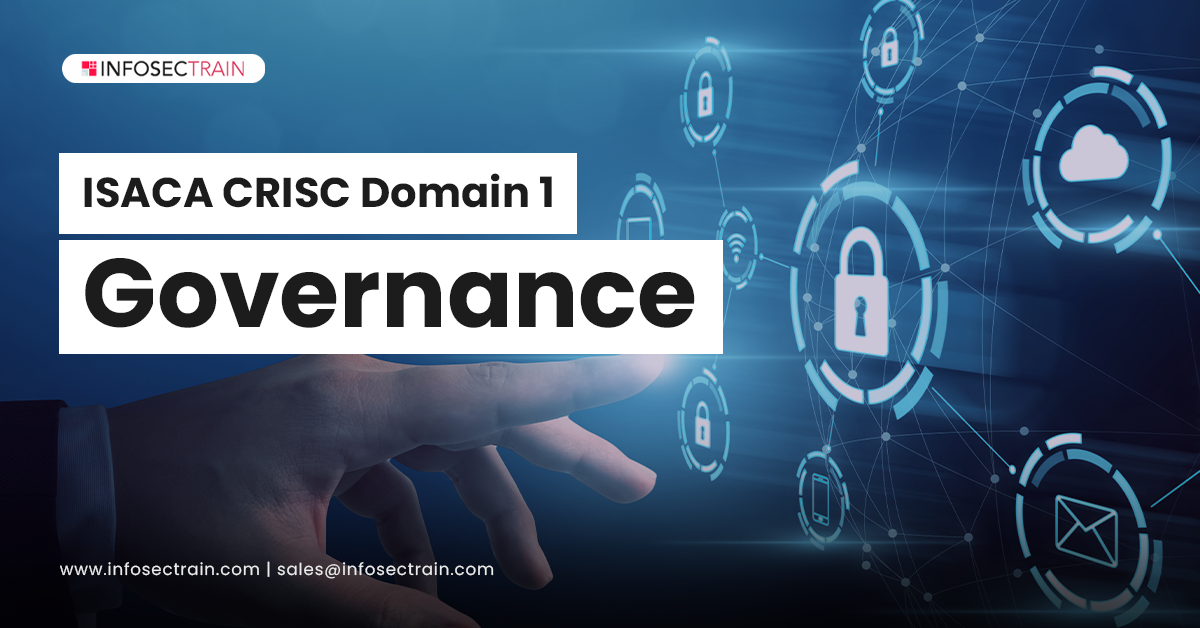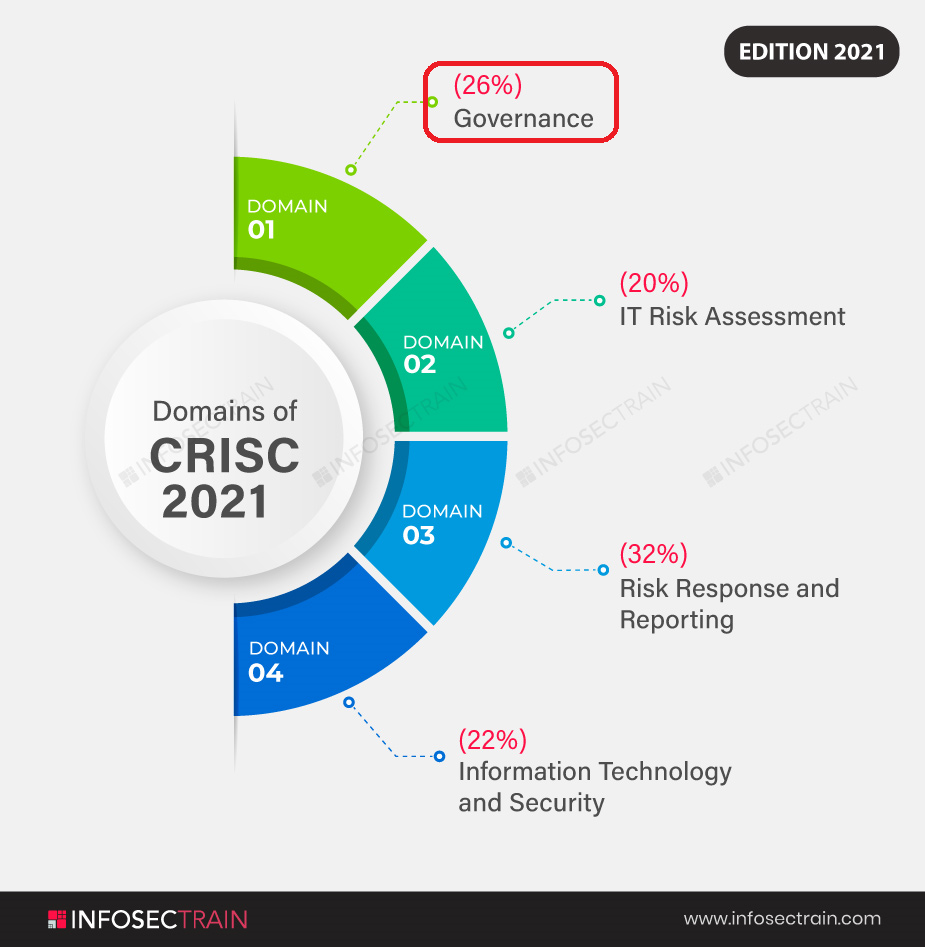ISACA CRISC Domain 1: Governance
As businesses adapt to the digital age, banks are far from the only areas where cybercrime has taken hold. Businesses are like the Golden Goose, vulnerable to hackers and fraud because they own a substantial amount of data and information. With the increasing threats to the organization, the risk team requires experts who can protect them from the dreaded elements. CRISC is one of the most well-known certifications that confirms your ability to avoid security breaches. Because CRISC holders are in high demand all around the world, this confirmation provides you with a specialty in your field with higher pay.

CRISC
The CRISC (Certified in Risk and Information Systems Control) certificate from ISACA (Information Systems Audit and Control Association) certifies experience in assessing and managing enterprise IT risk and implementing information systems controls. Risk management is a key topic for every company, hence a Risk Management specialist is always in demand. CRISC certification validates your knowledge and abilities in risk management in the workplace. It will also help you cope with any risks that your company may encounter. CRISC will help you earn reputation and recognition if you want to develop in your job.
Domains of CRISC
CRISC comprises the following four domains, which basically explains the entire Risk Management Life Cycle:
- Domain 1: Governance (26%)
- Domain 2: IT Risk Assessment (20%)
- Domain 3: Risk Response and Reporting (32%)
- Domain 4: Information Technology and Security(22%)

We are going to explain the first domain, which is ‘Governance’.
Domain 1: Governance
The structure by which an organization is governed and operated, as well as the processes by which it and its personnel are held accountable, is referred to as governance. Governance is the responsibility for safeguarding an organization’s assets. The organization’s board of directors is responsible for governance, and the board entrusts the senior management team with the duty of managing the organization’s day-to-day operations in accordance with the board’s authorized strategic directives. Financial accountability and supervision, operational performance, legal and human resource compliance, social responsibility, and IT investment, operations, and control all fall under the umbrella of governance.
In regards to examples illustrating the significance of effective governance and, on the other end of the spectrum, global corporate catastrophes, the term “governance” has risen to the forefront of business thought during the last decade. The method through which corporations are assessed, directed, and regulated is known as corporate governance. The method through which the present and future usage of IT is reviewed, directed, and regulated is known as IT corporate governance. Any governance system’s goal is to help companies produce value for their stakeholders.
Domain 1 of the CRISC exam holds 26% weightage which is more than one-fourth of the exam and it is bifurcated into:
Organizational Governance
- Organizational Strategy, Goals, and Objectives
- Organizational Structure, Roles, and Responsibilities
- Organizational Culture
- Policies and Standards
- Business Processes
- Organizational Assets
Risk Governance
- Enterprise Risk Management and Risk Management Framework
- Three Lines of Defense
- Risk Profile
- Risk Appetite and Risk Tolerance
- Legal, Regulatory, and Contractual Requirements
- Professional Ethics of Risk Management
Domain 1, Governance, reveals all about organizational and risk governance.
- It outlines how the key concepts of risk impact the enterprise.
- It defines the concepts of enterprise risk management.
- It explains the difference between governance and management functions.
- It provides knowledge of how to assess risk frameworks and their role in enterprise risk management.
- It also describes the relationship between enterprise risk and IT risk.
- It illustrates the role of the risk practitioner in the three lines of defense.
- It clarifies roles and responsibilities within the organizational structure and explains how they relate to risk management.
- It also explains the types of risk profiles.
- It outlines the impact of organizational culture on risk management.
- It provides an understanding of the relationship between risk appetite and risk tolerance.
- It provides knowledge of how to identify organizational assets and how they are valued.
- It provides awareness of the impact of legal, regulatory, and contractual obligations regarding risk management.
- It explains how policies and standards provide direction to the enterprise.
- It demonstrates the importance of professional ethics in risk management.
- It specifies how the business process reviews help improve enterprise effectiveness.
Key Takeaways of Domain 1
After the complete study of domain 1, an aspiring CRISC professional must be able to:
- Understand risk management strength and financial disclosure quality
- Know the non-IT Manager’s role in enterprise IT Risk Management
- Possess knowledge of Pandemic-Driven Remote Working and Risk Management Strategies
- Cognizance of Fintech Governance Challenges, Levels and Theories
- Have an idea of the Role of IT Governance During COVID-19 and Beyond: Keeping the Momentum
- The sheer gravity of comprehending culture as an IT Governance Risk handler
- Understand if the organizations are actually performing risk-based audits
- Connect good Governance with key risk
- Drive successful outcomes by crowdsourcing Risk Management
- Move Risk Management from fear and avoidance to performance and value
- Have knowledge of roles of Three Lines of Defense for Information Security and Governance
- Comprehend Human Error: A vastly underestimated Risk in Digital Transformation Technology
CRISC with InfosecTrain
CRISC Certification is a sign of risk assessment and information standard monitoring competence and skills. This certification equips the applicant with the necessary attitude to effectively advance up the professional ladder in today’s competitive environment. You must buckle down for the certification exam if you want to stand out from the crowd and expand your job possibilities. InfosecTrain’s CRISC certification course will introduce you to the specific challenges of IT and business risk management. Because we are a significant training provider in the globe, we utilize highly qualified trainers who are experts in the field to create the entire action plan. Experienced professionals at InfoSecTrain will walk you through the process of building a solid CRISC foundation in order to upskill your risk management knowledge to a competent level. You can have a good chance of passing the exam on the first try if you have a solid approach, total devotion, and great resources. Join our training program and go on the fast track to success.







 1800-843-7890 (India)
1800-843-7890 (India)